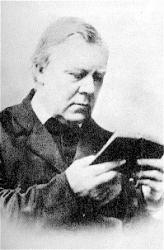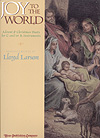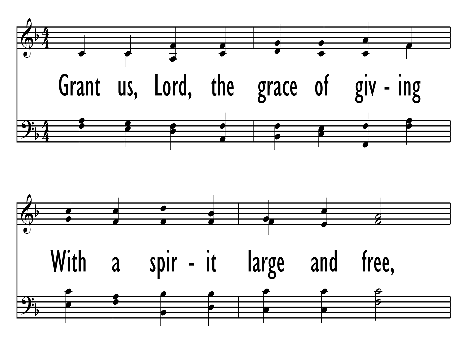- |
User Links
Hark! a Thrilling Voice Is Sounding

Hark! a thrilling voice is sounding
Translator: Edward CaswallTune: MERTON (Monk)
Published in 142 hymnals
Printable scores: PDF, MusicXMLPlayable presentation: Lyrics only, lyrics + musicAudio files: MIDI, Recording
Representative Text
1. Hark! a thrilling voice is sounding:
"Christ is nigh!" it seems to say,
"Cast away the dreams of darkness,
O ye children of the day!"
2. Wakened by the solemn warning,
Let the Earth-bound soul arise;
Christ, the Sun, all ill dispelling,
Shines upon the morning skies.
3. Lo! the Lamb, so long-expected,
Comes with pardon down from Heav'n;
Let us haste, with tears of sorrow,
One and all to be forgiv'n.
4. So when next he comes with glory
And the world is wrapped in fear,
With his mercy he may shield us,
And with words of love draw near.
5. Honor, glory, might, and blessing
To the Father and the Son,
With the everlasting Spirit,
While eternal ages run.
Source: Hymns and Devotions for Daily Worship #14
Translator: Edward Caswall
 Edward Caswall was born in 1814, at Yately, in Hampshire, where his father was a clergyman. In 1832, he went to Brasenose College, Oxford, and in 1836, took a second-class in classics. His humorous work, "The Art of Pluck," was published in 1835; it is still selling at Oxford, having passed through many editions. In 1838, he was ordained Deacon, and in 1839, Priest. He became perpetural Curate of Stratford-sub-Castle in 1840. In 1841, he resigned his incumbency and visited Ireland. In 1847, he joined the Church of Rome. In 1850, he was admitted into the Congregation of the Oratory at Birmingham, where he has since remained. He has published several works in prose and poetry.
--Annotations of the Hymnal, Charles Hutchins, M.A. 1872… Go to person page >
Edward Caswall was born in 1814, at Yately, in Hampshire, where his father was a clergyman. In 1832, he went to Brasenose College, Oxford, and in 1836, took a second-class in classics. His humorous work, "The Art of Pluck," was published in 1835; it is still selling at Oxford, having passed through many editions. In 1838, he was ordained Deacon, and in 1839, Priest. He became perpetural Curate of Stratford-sub-Castle in 1840. In 1841, he resigned his incumbency and visited Ireland. In 1847, he joined the Church of Rome. In 1850, he was admitted into the Congregation of the Oratory at Birmingham, where he has since remained. He has published several works in prose and poetry.
--Annotations of the Hymnal, Charles Hutchins, M.A. 1872… Go to person page >Text Information
Related Texts
| First Line: | Hark! a thrilling voice is sounding |
| Title: | Hark! a Thrilling Voice Is Sounding |
| Latin Title: | Vox clara ecce intonat |
| Translator: | Edward Caswall |
| Meter: | 8.7.8.7 |
| Source: | Latin hymn, 5th cent. |
| Language: | English |
| Copyright: | Public Domain |
- Year A, Advent, First Sunday
This is recommended for Year A, Advent, First Sunday by 2 hymnal lectionary indexes including Lift Up Your Hearts: psalms, hymns, and spiritual songs #478. - Year A, Advent, First Sunday
Notes
Scripture References:
st. 1 = Rom. 13:11-12
st. 2 = 2 Pet. 1:19
st. 3 = John 1:29
st. 4 = Luke 21:25-28
st. 5 = Rev. 5:13
Although earliest manuscript copy dates from the tenth century, this text is possibly as old as the fifth century. It is based on the Latin hymn 'Vox clara ecce intonat" and its 1632 revision "En clara vox redarguit." The text in the Psalter
Hymnal is a revision of both Edward Caswall's (PHH 438) translation in his Lyra Catholica (1849) and the translation in Hymns Ancient and Modern (1861).
The hymn is most useful for Advent because it permits various interpretations of Christ's coming. Stanzas 1-3 contain references to Christ's first coming, but they can be used to celebrate his second coming as well. Stanza 4 surely refers to the second coming, and stanza 5, the only stanza addressed to God, is a doxology.
Liturgical Use:
During Advent for worship services that stress Christ's second coming; use stanza 5 as an Advent doxology.
--Psalter Hymnal Handbook
Access 4 additional articles on the Canterbury Dictionary of Hymnology:
- Hark! a herald voice is calling
- Hark! a thrilling voice is sounding
- Hark! an awful voice is sounding
- Vox clara ecce intonat
Tune
MERTON (Monk)William H. Monk (b. Brompton, London, England, 1823; d. London, 1889) composed MERTON and published it in The Parish Choir (1850). The tune has been associated with this text since the 1861 edition of Hymns Ancient and Modern. The tune's title is thought to refer to Walter de Merton, founder of Mert…
Timeline
Arrangements
Piano/OrganMore Piano/Organ... |  |
InstrumentalMore Instrumental... |  |
PowerPointMore PowerPoint... |  |
Media
- MIDI file from The Cyber Hymnal #2639
- Audio recording from Evangelical Lutheran Worship #246
- Audio recording from Lift Up Your Hearts: psalms, hymns, and spiritual songs #478
- Audio recording from Lift Up Your Hearts: psalms, hymns, and spiritual songs #478
- Audio recording from Lift Up Your Hearts: psalms, hymns, and spiritual songs #478
- MIDI file from Psalter Hymnal (Gray) #332
- MIDI file from Psalter Hymnal (Gray) #332


 My Starred Hymns
My Starred Hymns

